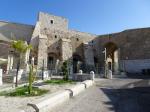Trani
Trani is a historic fishing port in Puglia, southern Italy, between Bari and Barletta on the Adriatic coast.
Dating to the twelfth century, the cathedral is dedicated to St. Nicholas the Pilgrim, a different St. Nicholas to the famous saint venerated in nearby Bari. The building is wonderfully imposing and is one of the most renowned sights of Puglia. The exterior is chiefly Romanesque in style, with a tall elongated facade, rose windows and a stately campanile. Its decorative bronze doors (now displayed inside) are the work of a local artist, Barisano da Trani. The interior has been stripped back to its original Romanesque appearance: simple, lofty and attractive with a few appealing details such as carved stone figures supporting columns. The building has several levels: beneath the main church is an older one dedicated to Santa Maria della Scala, with some remaining Byzantine frescoes. At a still lower level is a chamber said to date to the sixth century. The church's main crypt contains the remains of the saint. Up in the main church, are the surviving sections of a 12th-century mosaic showing Alexander the Great and Adam and Eve.
Near the cathedral is the church museum, the Museo Diocesano, which exhibits a collection of sculpture and archaeological finds from Trani's churches.
Trani's defensive fortress, the Castello Svevo, is on the shore just beyond the cathedral. It dates to 1249 and is one of the many castles built in southern Italy by the Holy Roman Emperor Frederick II, one of the area's most interesting historical figures. For a long period (until the 1970s) the building was used as a prison; nowadays it's open as a tourist attraction. The castle houses occasional exhibitions and special events.
On the low headland behind the cathedral is the oldest part of Trani's historic centre. The most famed of Trani's historic dwellings is the fifteenth-century Palazzo Caccetta on Via Ognissanti, which belongs to the council. Nearby is a twelfth-century church built by the Knights Templar, the Chiesa di Ognissanti. Trani was on a route used by crusaders heading to and from the Holy Land, and there was a hospital here for the sick and wounded. You can see the exterior of the church from the harbourside (the curved apse) or from the lane the other side of the building.
Inland towards the railway station the streets are more modern but despite the traffic which runs along them, there is still a rather old-worldly air to the wide pavements and shops.
There is a pleasant walk around the harbour, with benches to sit on while passing the time. From the breakwater at the south-eastern side there are great views back towards the cathedral. This is one of my favorite places in the whole of the Puglia region. After a busy day touring the area it was nice to come back to the hotel and go for a walk along the waterfront to a pleasant outdoor cafe and sit and enjoy a beer and just watch people going about their everyday business.
|



























